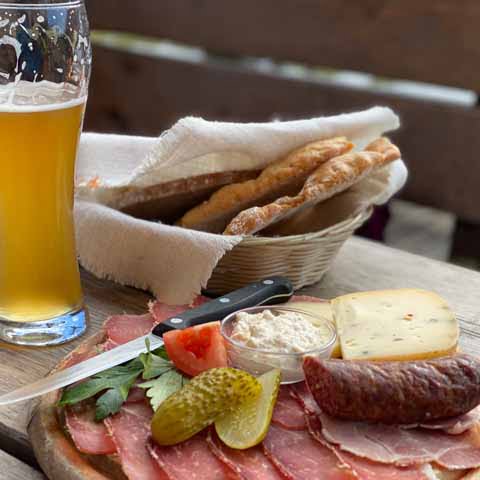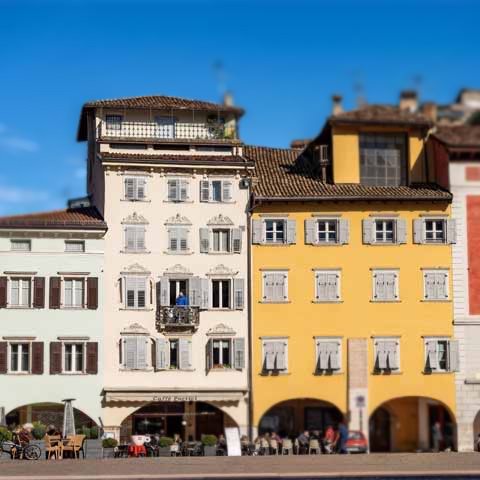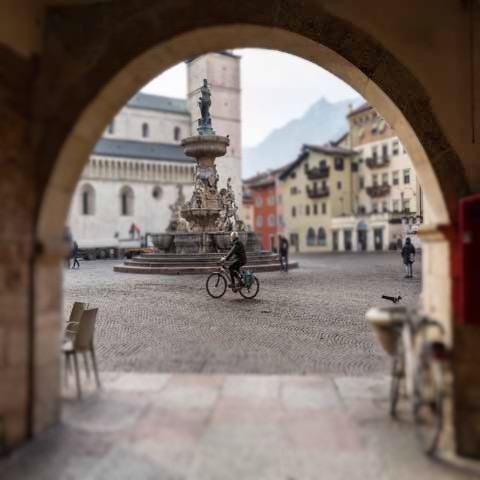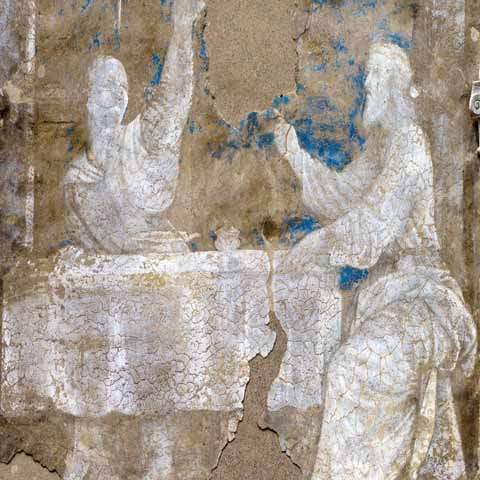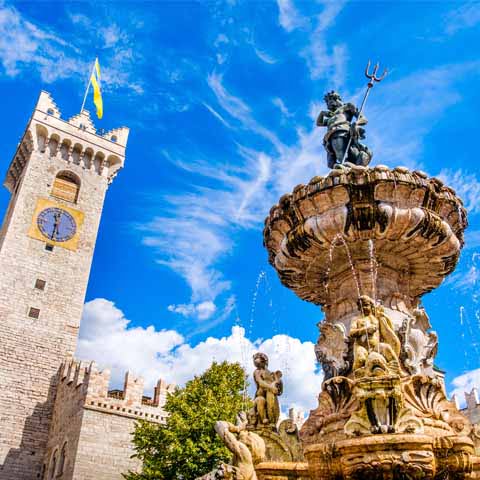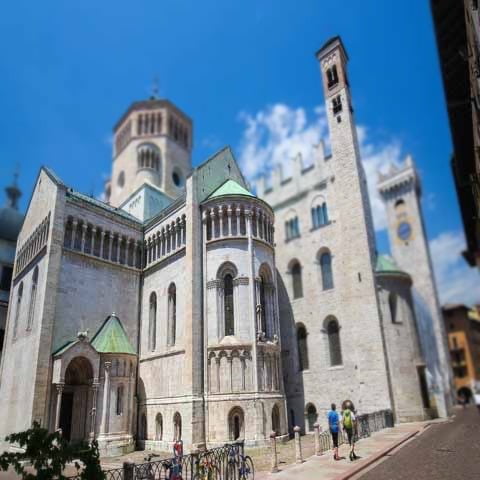As the capital of the region of Trentino-Alto Adige, the city of Trento is a modern university city with a long, multicultural history. It was the home of the historic Council of Trent and boasts a large student population that attends the University of Trento. The result is a city with a culture that remembers and honors the past while celebrating and creating the future. A visit to Trento promises historical and modern art and architecture, beautiful scenery, and rich and vibrant culture.
ART IN TRENTO
Like the rest of Italy, art is showcased throughout Trento in churches, palaces, art museums, and even the city streets.
Visit Palazzo delle Albere, a villa with a moat and castle-like towers, to see many frescoed walls. For years, it was also the home of the Museum of Modern and Contemporary Art of Trento and Rovereto (MART) – a modern museum center. The MART is now located in nearby Rovereto and contains a variety of modern and contemporary works. There are more than 15,000 pieces of art spanning multiple mediums – paintings, sculptures, drawings, engravings, and more. Trento’s Civic Gallery also displays modern and contemporary art and is considered to be an extension of the MART.
Palazzo Pona Geremia, a Renaissance palace built between the end of the fifteenth and beginning of the sixteenth centuries, also features artistic frescoes as well as a stunning façade. One of the rooms of the building also hosts temporary exhibitions.
Located in the heart of Trento in the Palazzo Pretorio is the Tridentine Diocesan Museum. Built in 1903, it houses notable artistic pieces and cultural artifacts from the eleventh to nineteenth centuries. The exhibits are organized chronologically and by subject, so travelers can enjoy exhibits on paintings, tapestries, sculptures, and artifacts that document the Council of Trent.
ARCHITECTURE
The architecture of Trento is equally as important to the city’s culture as its art. Throughout the city, travelers will experience buildings that have Italian and German influences from a variety of time periods.
Trento’s Cathedral is a stunning Roman-Gothic structure. Built in the twelfth century and modified throughout the centuries, the Duomo has a variety of unique features. Some of the most impactful architectural features include the fifteenth-century tower, mullioned windows, decorative altars, a large rose-shaped window, and sculptural elements such as lions and columns.
The Basilica Santa Maria Maggiore dates back to the sixteenth century and was built over the Paleo Christian Church of Santa Maria ad Nives. The artistic treasures found in this church include the historic organ and choir, intricate altarpieces, and organ doors painted by Giovanni Maria Falconetto.
The Church of San Pietro, which was constructed during the fifteenth century, has a Neo-Gothic façade from the middle of the nineteenth century. The church features an impressive belltower and a marble altar with stunning sculptures of Saint Peter and Saint Paul.
A walk down Via Belenzani, one of Trento’s most beautiful streets, is home to a variety of Venetian-Renaissance structures. Other architectural features, such as mullioned windows and colorful frescoed walls, can also be observed.
An architectural must-see in Trento is Castello del Buonconsiglio. Built in the thirteenth century and altered throughout the centuries, the architecture of the building has shades of Renaissance, Gothic, and Venetian styles. This stunning castle complex features a main tower, original stonework, a courtyard, and rooms filled with Gothic art.
Churches such as the small, but unique Roman-Gothic Sant’Apollinare and the historic Renaissance church Santa Maria Maggiore (the site of the third session of the Council of Trent) are also great ways to explore the city’s architectural history.
In addition to churches, castles, and palaces, there are other architectural structures peppered throughout Trento, such as the Torre Vanga, a twelfth-century tower built to protect the Adige River, and the Mausoleum dedicated to Cesare Battisti, a son of Trento and celebrated Italian patriot.
LITERATURE IN TRENTO
Literature and education are central to the culture of Trento, as the city is home to the University of Trento, a major university founded in 1962. It hosted the first Faculty of Sociology in Italy and in the early 1970s, the university created the Faculties of Science and Economics. Eventually, Faculties of Art, Law, and Engineering were created, cultivating the cultural importance of higher education, learning, and cultural openness throughout the city.
MUSIC
Trento’s music history was highly impacted by the Council of Trent, an event that started the Counter-Reformation of the Roman Catholic Church. The religious impact of the Council of Trent made it so that little music outside of ecclesiastical style songs became popular.
The first commercial music venue was not created until 1819. The Teatro Mazzurana was opened and brought music and theater to the people of Trento. Other music venues eventually opened – the Auditorium, the Sperimentale, and the San Marco Theater.
Today, music in Trento reflects the multicultural and bilingual heritage of the Trentino-Alto Adige region. There is a deep-rooted culture of choral music, mountain village bands, and folk music throughout the area.
Trento is also home to the Bonporti Music Conservatory, a music school that hosts an annual music festival and orchestral conducting competition, as well as the Philharmonic Society, which was founded at the end of the eighteenth century with the goal of bringing musicians together.
SCIENCE
Along with the University of Trento, which features a Faculty of Science, there are a variety of ways that the culture of Trento is influenced by science, mainly through the various science museums throughout the city.
The Museo Diocesano Tridentino (Trento Natural Science Museum) hosts various scientific exhibitions – geology, history, zoology, botany, and more. It features temporary and permanent scientific exhibitions and is a center for international scientific research and education. It maintains databases for Alpine Nature and is the main hub for the network of regional museums.
The Museum of Science, or MUSE, is another interesting museum. The museum itself is housed in a modern architectural structure and the exhibits within range from natural environment to geology to taxidermy.
In the Trento International Airport, travelers can visit the Museum of Aeronautics Caproni. It holds an old aircraft hangar that features a selection of airplanes from throughout history.
CINEMA
Due to its stunning natural scenery, several movies have been filmed in the province of Trentino over the years. A few notable examples include Colpi di fulmine (2012), La prima neve (2013), and In fondo al bosco (2015).
Travelers visiting Northern Italy should plan to spend time in the charming Alpine city of Trento. From the breathtaking scenery to the historic architecture and remarkable frescoes, Trento is filled with cultural delights.
Travel Guides
The Trentino Alto Adige Region of Italy
The Cities of Trentino Alto Adige, Italy
